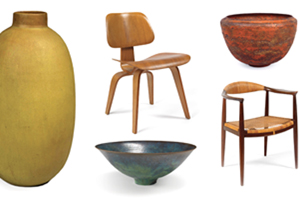Design of the times
A Smart Museum lecture and exhibit show how Western design became a weapon in the Cold War.
By Katherine Muhlenkamp
Images courtesy Smart Museum of Art

Objects from the Smart Museum’s “Good Design” exhibit were displayed in Europe during the Cold War to represent capitalist innovation.
Art-history doctoral candidate Maggie Taft pressed a key on her laptop, and a 1959 photograph of then–U.S. Vice President Richard Nixon and Soviet leader Nikita Khrushchev’s famous kitchen debate flashed on a screen. While the two leaders engage in a pointed back-and-forth, a horde of reporters gathers behind them. In the foreground sits a General Electric model kitchen, complete with washing machine, table, and a box of S.O.S scouring pads. The image kicked off Taft’s July Smart Museum of Art lunch talk on how design—and contemporary home furnishings in particular—were used to brand both East and West during the Cold War.
The lecture was an offshoot of the Smart’s summer exhibition, “Mid-Century: ‘Good Design’ in Europe and America, 1850–1950,” which showcased 1940s- and ’50s-era pieces by American and Western European designers, such as Charles and Ray Eames plywood chairs. Streamlined and functional, employing new materials and technologies, the objects were high quality yet affordable. In the early 1950s, the U.S. Information Agency displayed these sorts of pieces—often dubbed “good design” by curators and critics—at Western European exhibits. Organizers of the overseas shows, Smart Senior Curator Richard A. Born says, touted the designs as the fruits of capitalism and democracy, the result of designers working to meet consumer demand in a free-market economy.
Taft, whose dissertation explores how furniture design in mid-century Denmark came to represent Danish identity, addressed the Cold War politicization of modernist design, focusing on the American National Exhibition in Moscow. Opening in July 1959 and attracting 2.7 million visitors, the exhibit was held in Sokolniki Park, “a result of a U.S. and USSR agreement made in 1958 to exchange national exhibits on science, technology, and culture,” said Taft. A similar Soviet show was held at the New York Coliseum. The Moscow exhibition focused on American domesticity and lifestyle, showcasing a 360-degree Disney film that presented rituals of American life, a car show, and several full-scale dwellings. The most popular display was a six-room, ranch-style home.
The ranch house had precedents, Taft noted, including a model home featured in “We’re Building a Better Life,” a 1952 U.S.-sponsored exhibition in West Berlin. The Berlin house contained 6,000 products, all manufactured in Marshall Plan–member nations, including the Eames chairs displayed in the Smart exhibit.
The Moscow display, nicknamed “Splitnik” to play on Sputnik and to reference the home’s ten-foot-wide corridor, featured actors portraying the quintessential American family. Taft’s audience smiled as she showed a picture of a cheerful woman baking in the Splitnik kitchen. It was in that same lemon-colored location, Taft said, where the famous photo of Nixon and Khrushchev’s “Kitchen Debate” was taken. “Despite the impromptu appearance of things—it seemed as though Nixon and Khrushchev were just walking through, Nixon made a comment, then they started discussing commodities—the Americans had in fact planned the discussion in advance,” she said. “Reporters had been invited to scope out spots the night before to get prime shots.”
The discussion centered on consumption patterns and whether capitalism or communism produced better material conditions, Taft continued. Referencing the shiny new kitchen, Nixon praised the virtues of private space and property, self-expression through acquisition of goods, the leisure time afforded through technological advancement, and the freedom of choice offered to the American consumer. “To us, diversity, the right to choose, is the most important thing,” he said. “We don’t have one decision made at the top by one government official. We have many different manufacturers and many kinds of washing machines so that the housewife has a choice.”
Khrushchev countered that the items were extravagant and conducive to sloth. “Don’t you have a machine that puts food into the mouth and pushes it down?” he asked sarcastically. Soviet leadership at the time, Taft explained, was reconciled to the idea of consumer consumption, but instead of private property, proposed a system of rental commodities. The reconciliation, Taft pointed out, was conceived out of necessity because many commodities were in short supply.
Western domestic technology may have surpassed the USSR’s offerings for most of its citizens, Taft said, but many Eastern Bloc designs mirrored those of the West. Clicking to an image of a prefab white, blue, red, yellow, and black modernist kitchen designed by Estonia’s Standard Experimental Furniture, she noted that it “doesn’t look all that different from a lot of very familiar patterning. You can imagine an Eames shelving unit in one corner.” Rather than acknowledging that Estonian designers had assimilated Western design principles, the Soviets touted this look as a formal aesthetic originating in Soviet republics.
Similarly, she said, “you can also see similarities and formal likeness” between a serving set by Russel Wright with items from the 1930s and ’40s, featured in the Smart’s “Good Design” exhibit, and one by Polish sculptor Lubomir Tomaszewski (circa 1961). “The simple curving forms, subtle colors, and curved lines at the top.” In the Soviet Union, the availability of such objects was strictly controlled by the government. In fact, Soviet advertisements often promoted goods that weren’t available at all. “The effect was to say, ‘Look at what you can have. Look at what we’ll promise you.’” Some scholars have argued, Taft said, that “the design revolution in the Soviet Union was much more a matter of images than a matter of things, because that’s where the innovation really took place—on paper and through pictures.”Return to top
